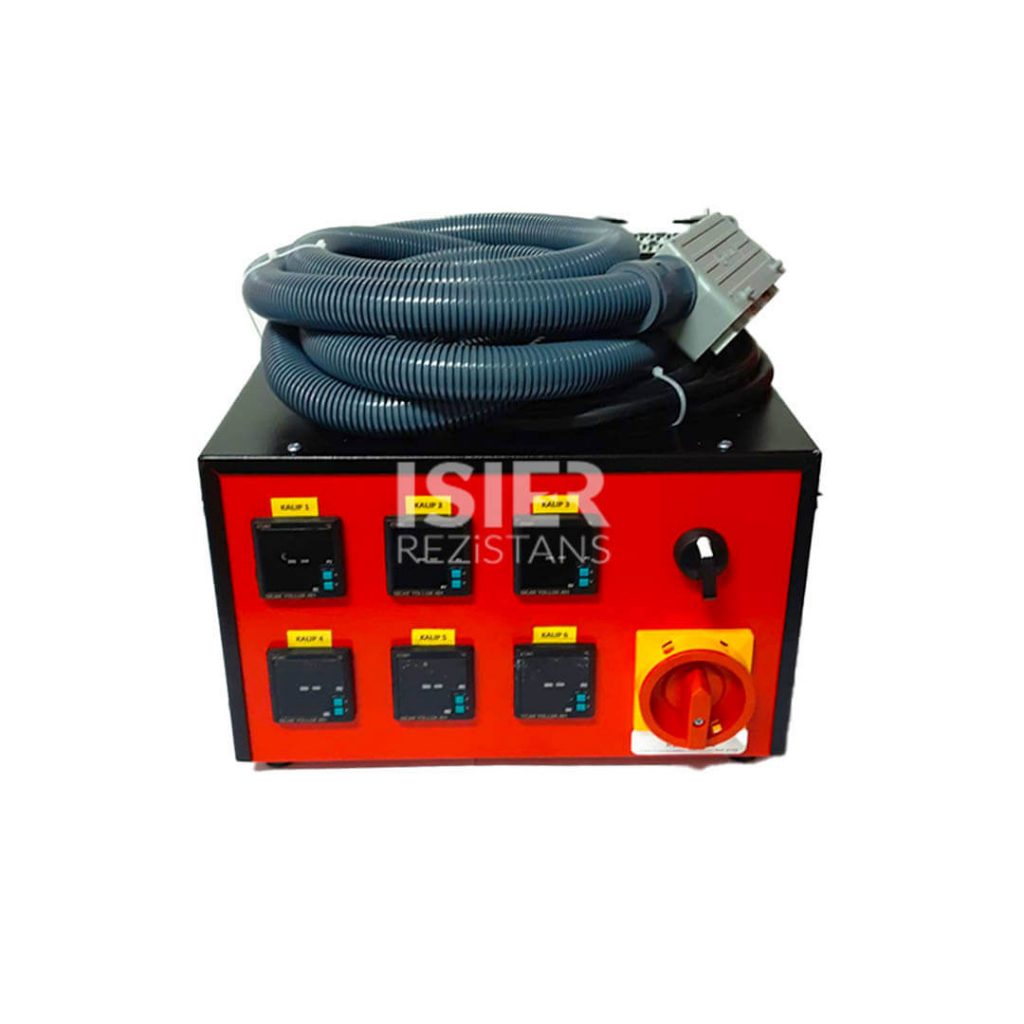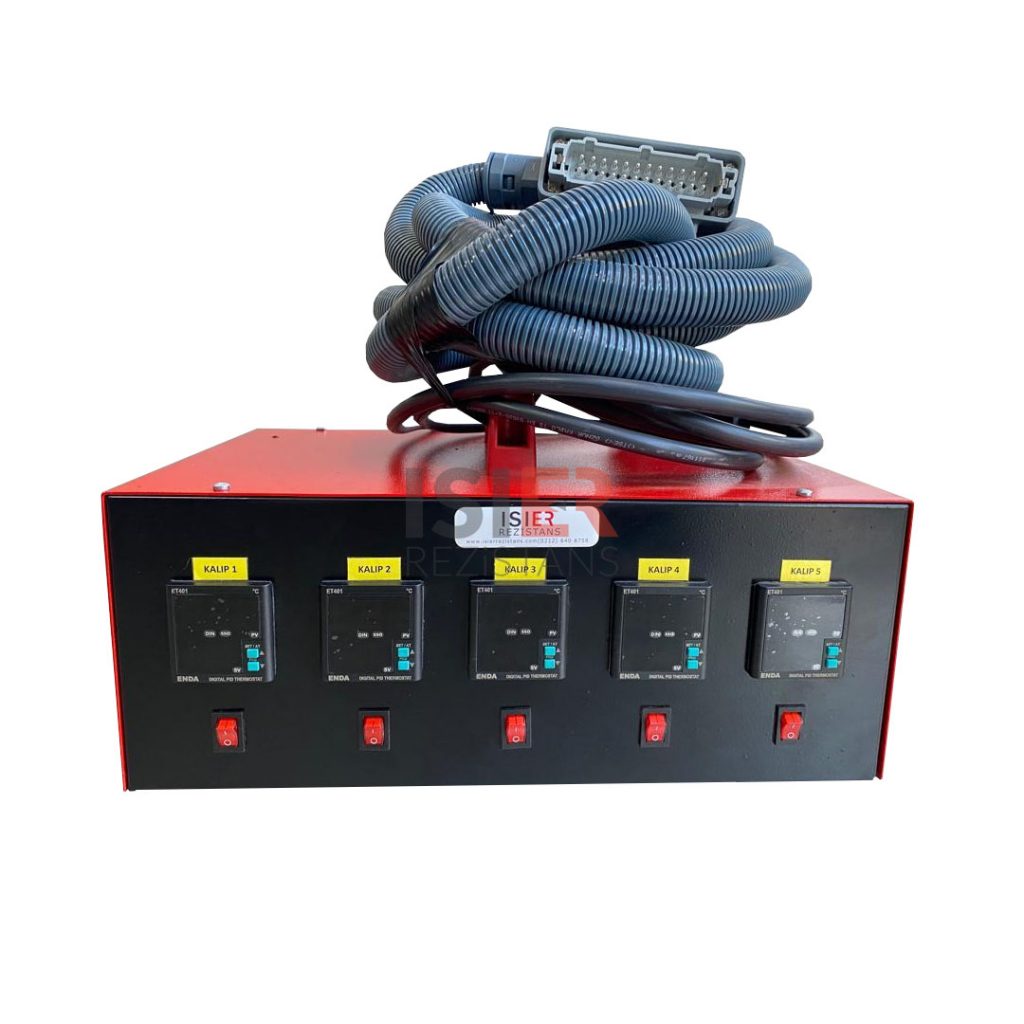Heat Control Devices
Heat Control Devices, which are used as a control mechanism in case the temperature rises too high in any case or falls below the desired temperature, are among the most used control devices today. Heat control devices are used to control a heater or other equipment by comparing a sensor signal that can detect the temperature of the target point with a set point and making calculations according to the deviation between these values.
These devices are the heat control system of multi- and single-cavity hot runner molds. Heat control devices can be prepared according to the number of needs from a single module to 18 modules.
Technical Information
These devices come to the fore with their high precision PID temperature control and Soft/Start Operation features. These devices also come to the fore with their Output power 16A-2500W/Channel and SSR (Solid State Relay) Controlled Operation system. It also offers a perfect service with its ability to work in the event of a thermo element failure, which is one of its most important features. Finally, Thermocouple / Fe-Cuni, 2.5 mt. The patch cable (power/signal) has become a frequently used product in industrial areas with its 230V 45-65hz supply voltage features.
These devices, which are indispensable equipment not only for heaters but also for coolers, are necessary devices for the devices to work properly in the desired temperature range. Although they have the same logic as other heat control systems in terms of working principle, they can also work in high temperature conditions. The devices, which have different models that can serve between 1-12 channels, can work with high precision and can perfectly meet the temperature control function in the industrial field.
Heat Control Devices is a control device with analog setting and digital measurement of the measured value. It controls the temperature in the objects by turning the electrical controller on and off according to the precise set point of the controller. In devices designed according to the needs, multiple resistances can be easily controlled at the desired temperatures with auto tuning and PID support, either in line with customer demand or with a standard connection scheme.
Heat Control Devices
Heat Control Devices are commonly used control mechanisms in modern times. These devices intervene in cases of abnormal temperature rise or fall below the desired temperature, and they are utilized in many industrial processes. Typically, they receive real-time temperature data via a sensor and compare it with the specified target temperature. Based on the deviation value resulting from this comparison, they control heaters or other equipment.
These devices can be adapted for a wide range of temperature control needs. For instance, they can be used in heat control systems for single or multiple chambered heated molds. They can expand from a single module up to 18 modules according to requirements. They are supplied as completed and ready-to-operate modules, along with components such as Solid State Relays (SSRs), fuses, and intermediate cables.
Heat Control Devices provide a reliable and effective solution for temperature control in industrial processes.
Technical Specifications
Heat Control Devices stand out with their high-precision PID temperature control and Soft/Start Operation features. Additionally, they distinguish themselves with an output power of 40A-2000W per channel and operate with SSR (Solid State Relay) Controlled Operation system. The ability to continue operating even in the event of a thermocouple failure ensures flawless service of these devices. Compatible with various thermal elements such as thermocouples or Fe-Cuni, they have become preferred products in industrial fields with 3-meter intermediate cable (power/signal) and 230V 45-65Hz power supply.
Not only important for heaters but also for coolers, these devices ensure the healthy operation of devices within the desired temperature range. Despite having the same logic as other temperature control systems, they can effectively operate even under high-temperature conditions. With various models serving 1-12 channels, these devices can operate with high precision in industrial fields and excellently fulfill the function of temperature control.
Heat Control Devices are control devices with analog settings and digital measurement of the measured value. They control the temperature in objects by opening and closing the electrical control device according to the set point of the control device. Designed according to needs, these devices can easily control multiple heaters at desired temperatures with auto-tuning and PID support, providing flexibility tailored to customer demands.
Areas of Use Heat Control Devices
Heat Control Devices have a wide range of applications and are used for temperature control in various industrial processes, including:
Plastic Injection Molding: In plastic injection molding processes, heat control units are used to maintain the temperature balance inside the mold and facilitate quality injection processes.
Extrusion: Temperature control is critical in the extrusion processes of plastic, metal, or other materials. Heat control units enhance product quality by precisely controlling the temperatures in different zones along the extrusion line.
Casting: In casting processes of metals or alloys, heat control units regulate mold temperature to ensure smooth and consistent casting.
Chemical Processes: Temperature control is crucial in processes involving chemical reactions. Heat control units facilitate reactions to occur at desired temperatures and durations.
Food Industry: In food processing and manufacturing facilities, heat control units meet temperature requirements for various processes. They are used in many areas such as ovens, cooking kettles, and cooling systems.
Automotive Industry: In automotive part manufacturing, especially in plastic injection molding processes, heat control units are widely used. They ensure temperature precision in the production of interior and exterior trim parts, headlamp lenses, front panels, and other components.
Electronics Industry: Heat control units are used in the manufacturing and assembly of electronic components, covering various processes from soldering to molding.
Medical and Laboratory Applications: Heat control units are used in the production of medical devices and laboratory equipment. This includes various applications from sterilization processes to material testing.
These areas represent just a few of the common industrial applications where heat control units can be utilized. These devices are typically suitable for any process or production requiring precise temperature control.
Types of Heat Control Devices
Single Channel Control Units: Designed to monitor and manage a single temperature control point. They can be used in simple industrial processes and laboratory applications.
Multi-Channel Control Units: Capable of monitoring and managing multiple temperature control points. They are used in complex production processes in industrial facilities and for multi-zone control.
Digital Control Units: Equipped with digital displays and controls. They are used to set and monitor temperature values more accurately.
Analog Control Units: Equipped with analog adjustment knobs and indicators. They are preferred in simple industrial applications and older systems.
Compact Control Units: Small-sized control units integrated into a single box. They are useful in applications with limited space or mobile equipment.
Expandable Control Units: Have a modular structure and can increase the number of channels or add other functions as needed. They provide flexibility.
High-Power Control Units: Designed to control heating or cooling systems requiring high power. They are used in large-scale industrial facilities.
Hybrid Control Units: Can manage heating and cooling processes on the same device. They provide flexibility in thermal management.
Programmable Control Units: Can automatically perform temperature control at specific time intervals or under certain conditions. They are ideal for automatic operations.
Communication Capabilities: Models integrated with communication tools such as Ethernet, RS-485, or USB are available. They provide suitability for remote access and data recording.






